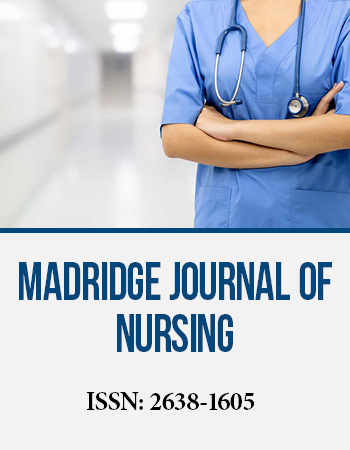Research Article
Prevalence of Substance Abuse among School Students in Muscat and Al-Mudhaibi in Sultanate of Oman: A Comparative Study
School of Pharmacy, College of Pharmacy and Nursing, University of Nizwa, Oman
*Corresponding author: Jamaluddin Shaikh, College of Pharmacy and Nursing, University of Nizwa, Oman, E-mail: jamaluddin@unizwa.edu.om
Received: October 24, 2022 Accepted: November 24, 2022 Published: December 01, 2022
Citation: Al-Mahruqi MS, Shaikh J. Prevalence of Substance Abuse among School Students in Muscat and Al-Mudhaibi in Sultanate of Oman: A Comparative Study. Madridge J Nurs. 2022; 7(1): 194-199. doi: 10.18689/mjn-1000135
Copyright: © 2022 The Author(s). This work is licensed under a Creative Commons Attribution 4.0 International License, which permits unrestricted use, distribution, and reproduction in any medium, provided the original work is properly cited.
Abstract
Background: As with the global trend, substance abuse is one of the public threats in the Sultanate of Oman. The prevalence of substance use among adolescents is frightening. The issue is not only destructive for individuals but also has adverse consequences for the public at large. However, the juvenile prevalence of substance abuse is not well defined in the Sultanate of Oman. The aim of this study is to evaluate the prevalence of substance abuse among secondary school students in Al-Mudhaibi, Ad-Dakhiliyah Governorate, and in the city of Muscat, Muscat Governorate, Sultanate of Oman.
Methodology: This study was carried out in Al-Mudhaibi and in the city of Muscat in the Sultanate of Oman during 2018 among secondary school students. To achieve the goals, a self-administered questionnaire was distributed at random to the schools. Male and female students in grades 9 through 12 took part. A questionnaire with 20 items was developed for the purpose of this study. It also included a section for gathering demographic information about the students. The collected data was analyzed to assess the studentsʼ responses. The obtained data was linked with the demographics of the students.
Results: A total of 764 students participated in this study. Data obtained from this study showed that about one-tenth (9.7%) of the respondents were abusing substances. Tobacco was the most commonly abused substance in this study (39%), followed by sedatives (24%), and stimulants (22%).The study also showed that a considerable percentage of abusers consumed alcohol (12%). The majority of the abusers began abusing substances before grade 10 (27%), followed by grade 9 (25%). Abusers usually used substances alone (51%), with friends (35%), or both. In the current study, approximately 35% of the abusers indicated that the primary reason for substance abuse is the study problem. The survey also estimated that more than half of abusers (59%) were familiar with numerous ways of distributing substances.
Conclusion: This study provided a prediction about substance abuse among school students in Al-Mudhaibi, Ad-Dakhiliyah Governorate, and in the city of Muscat, Muscat Governorate. According to the available data in this study, tobacco was the most commonly abused substance in both governorates for a variety of reasons, the most common of which was study problems. The current study also estimated that the pattern of substance abuse was comparable between the city schools and the rural schools, except that the prevalence was slightly lower in the rural schools.
Keywords: Substance abuse, Alcohol, Tobacco, Sedative, Stimulant, Oman.
Introduction
The abuse of substances is an escalating problem worldwide. Hundreds of thousands of people throughout the globe are abusing various illicit substances such as cocaine, methamphetamine, nicotine, morphine, marijuana, heroin, alcohol, and many others. A recent report indicated that around 284 million people aged 15–64 used substances globally in 2020. Young generations are abusing more substances, which indicate that the level of use today is higher than in earlier age groups in many countries [1].
Substance abuse is a type of harmful use of any material for changing oneʼs psychoactive status. Substances may consist of alcohol and other illegal drugs, as well as a number of substances that are not drugs at all. Abuse, on the other hand, may result from consuming a substance in a manner that is not intentional or endorsed or from consuming more than is recommended [2].
Substance abuse, a complex problem in modern life, is influenced by many factors. Peer pressure, genetics, family ecology, the presence of other mental health issues, developmental factors, and the community environment all play a role in substance abuse. However, there is no straightforward way to predict who will develop an addiction to drugs, but a combination of factors can increase an individualʼs risk of developing an addiction [3]. There are even more risk factors associated with adolescent abusers. These factors can be classified as individual, family, and community factors. Some of the individual risk factors are disloyalty, emotional control, low spirituality, pain disaster, assignment completeness, and screen time, the occurrence of ill-treatment or a poor upbringing, and having psychosis. Some of the familial risk factors are maternal smoking during pregnancy, poor parental emotional balance and lack of parental education, carelessness, inadequate management, extra pocket money, and substance-using relatives. One of the community risk factors is having peers who abuse substances [4].
Adults are not the only group associated with substance abuse; it also severely affects school students. Teenagers are the cluster of individuals most predisposed to addiction [5]. The dangerous period of beginning substance abuse originates during the teenage period, and the maximal practice of substance abuse arises among youth aged 18–25 years old [6]. At this susceptible age, teenagers have a strong predisposition toward testing, curiosity, and vulnerability to peer pressure, a revolution against authority, and poor selfesteem, which makes them a particularly vulnerable group of individuals to substance abuse [7]. In the course of the teenage years, the primary growth progression commonly includes shifting associations between the individual and the various situations to which the teenager is accustomed. Various types of substances and the timing of these dealings promote multiplicity in adolescents and act as sources of threat through this life cycle [8].
Early use of alcohol, tobacco, and illicit drugs are the predisposing elements for abusing those drugs in the future. According to available research, people who start drinking alcohol at a young age are more likely to continue drinking later in life [9].One of the most common and avoidable causes of premature death is tobacco use. Worldwide, most adult smokers start smoking in their teenage years [10]. In addition, teenagers who start smoking at an earlier age are also more likely to turn into habitual smokers [11]. Furthermore, cannabis and other substances are commonly associated with teenage regular tobacco users [12].
As with the global trend, substance abuse is becoming a public health concern in Middle Eastern countries. Although substance abuse is unacceptable from a social, cultural, and religious point of view in Middle Eastern countries, it is an alarming condition in this region [13]. As across the globe, drug abuse among teenagers in this region is a serious concern as well. It has serious consequences for the financial, public health, and permissible features of nationsʼ progress. The vulnerable groups using substances are the teenagers from poor families, the unemployed youth, and secondary school students [14]. A study from Saudi Arabia indicated that secondary school students abuse tobacco, consume alcohol, and use other illicit substances [13-15].
Oman is an Islamic country on the Arabian Peninsulaʼs southeast coast. There are nine governorates in Oman. AlMudhaibi is a rural area in Ad-Dakhiliyah Governorate, and Muscat is a cosmopolitan city in Muscat Governorate. In the Sultanate of Oman, not much information is available about the prevalence of substance abuse among youth, particularly among school students [16], and hence the status of substance-related complications is unknown. The purpose of the current study is to obtain an estimation of the drug abuse among school students in Al-Mudhaibi and Muscat in the Sultanate of Oman. This study may benefit the current institutes, administrations, and Ministries of Health and Education in grabbing the benefits of these findings for establishing a healthy culture.
Material and Methods
This is a questionnaire-based survey to estimate the prevalence of substance abuse among secondary school students in Al-Mudhaibi, Ad-Dakhiliyah Governorate, and Muscat, Muscat Governorate. A total of four schools, two boysʼ and two girlsʼ schools, have been chosen from Muscat. Similar numbers of schools have been chosen from Al-Mudhaibi as well. The study was conducted in 2018 by using self-administered questionnaires that included demographic parameters and questions about substance abuse. Studentsʼ demographic parameters were used in this study. The parentsʼ cultural parameters, like employment and education, were also included. Directly related questions concerning the onset of substance use, the type of substances, fellow substance users, reasons for abuse, disadvantages of substance use like being absent from school and medical problems associated with abuse, knowledge about the distribution of the substances, and the role of the school environment in substance abuse were all included in the questionnaire. 764 Omani students from grades ninth through twelfth participated in the survey. The questionnaires were based on the following standardized international questionnaires used in previous similar studies [17]. These questionnaires are translated into Arabic (the local language) and validated. The validity of the test was determined by testing a small population of subjects. All the obtained data were analyzed and illustrated in histograms using Microsoft Excel programs.
Results
The current study was carried out in Muscat and Al-Mudhaibi in the Sultanate of Oman for both genders and various grade levels among Omani students. The questionnaire was distributed during any class time and was collected from them at the end of their responses. Therefore, the response rate was 100%. The total number of respondents was 764. The percentage of male and female students participating was comparable (male: 48% vs. female: 52%), and participants were uniformly distributed among separate grades (grades 9 to 12). In relation to the educational qualifications of parents, most of them were higher education degree holders (38%), followed by high school graduates (30%).
As a part of the study, students were questioned if they had ever used substances other than those required for therapeutic grounds. The outcomes revealed that about one-tenth (9.7%) of the students informed us that they had abused drugs at least once in their lifetime (Figure 1). Among the students of two governorates, 14% of students from Muscat abused substances compared to 5% of abusers from Al-Mudhaibi.
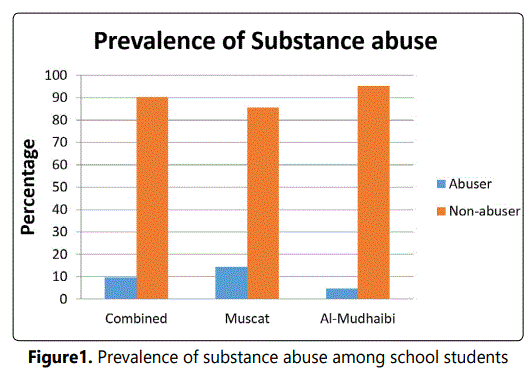
Regarding the initiation of substance abuse among ninth to twelfth graders, the majority of the abusers specified their starting point of substance abuse before grade 10 (22% before grade 9, 24% in grade 9, and 27% in grade 10). The segregation of data between the governorates indicated that the majority of students from Muscat confirmed the starting point of abuse was before grade 10 (before grade 9: 25%, grade 9: 29%, and grade 10: 28%), whereas students from Al-Mudhaibi reported the starting point of abuse was during the grades of 10 to 12 (grade 10: 22%, grade 11: 33%, and grade 12: 23%) (Figure 2).
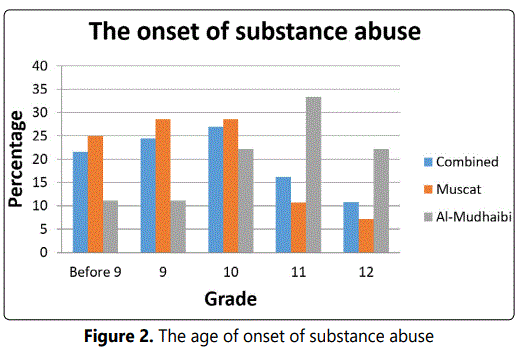
In relation to the commonly abused substances, the majority of the abusers confirmed the use of tobacco (39%), sedatives (24%), and stimulants (22%), as shown in Figure 3. About one-tenth of abusers (12%) reported their habit of consuming alcohol. The results also indicated that a small percentage of abusers were involved with other illicit drugs like glue (3%). There were similar trends in relation to the abused substances in both Muscat and Al-Mudhaibi. Isolation of data between the schools of two areas showed that abusers from Muscat consumed more alcohol than Al-Mudhaibi (15% in Muscat vs. 5% in Al-Mudhaibi), whereas abusers from Al-Mudhaibi used tobacco more than Muscat (50% in Al-Mudhaibi vs. 35% in Muscat).
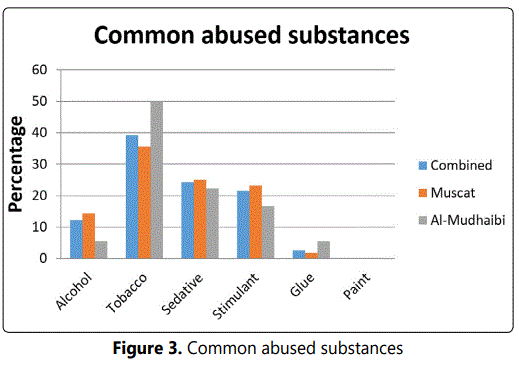
Figure 4. indicated that almost half of the abusers (51%) obtained substances when they remained alone. About one-third of them (35%) mentioned that they were going along with their friends to abuse substances. Only one-tenth (13%) of them abused substances with family members. When segregated into schools from two areas, it is indicated that the pattern of fellow abusers is the same in schools from both areas. The only difference was that the abusers in Al-Mudhaibi were more indulgent about taking substances alone than with friends (68% alone vs. 22% with friends).
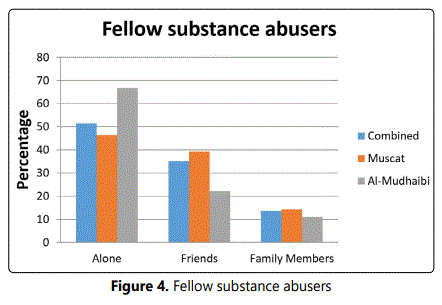
Concerning the attitude of the abusers in relation to the reasons behind the usage of substances, it was found that about two-fifths of the abusers (37%) acknowledged that study pressure was the key driving force for substance abuse. Additionally, bad relations (31%), poverty (18%), and complications in the family (12%) also contributed towards the habit of substance abuse. After isolating the data between schools in two areas, study pressure and bad relations were the main causes for abusing substances both in Mucat and Al-Mudhaibi (Figure 5). One of the differences between the two areasʼ schools was that poverty was one of the factors in Al-Mudhabi (17% in Muscat vs. 28% in Al-Mudhabi).
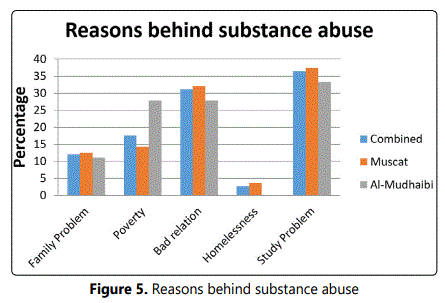
In the current study, abusers were asked whether substance abuse forced them to be absent from school. The data specified that more than one-third (38%) of them gave a confirmatory reply. This study also highlighted the fact that more than half of substance abusers (59%) are familiar with various methods of substance delivery. About one-third of abusers also admitted that the neighboring areas of the school were accountable for aiding the substance abuse.
Discussion
Standard of living, associations with society, educational, health, and economic status, and religious belief can influence public life. A small change that an individual experiences in his or her teenage years is regarded as the most decisive and demanding period in a personʼs life. Persons like to develop an independent identity at this stage, and, as a result, they get involved in many things that may even be risky not only for themselves but for the community as well. Substance abuse is one of the recurrent social catastrophes experienced by adolescents. According to the seriousness of this calamity, investigators ensure an allocation of studies to ease its prevalence among youth.
This study was undertaken to evaluate the prevalence and pattern of substance abuse among secondary school students in Muscat and Al-Mudhaibi, Sultanate of Oman, and measure some of the circumstantial background of substance abuse. Although it is improper to abuse substances on cultural, social, and religious grounds in Middle Eastern countries, the latest trend indicates that it is an alarming situation in these countries [13, 18].
The pattern for substance abuse in secondary school assessments indicated that about one-tenth of the participants in the current study misused substances. The higher percentage of students from Muscat who abused substances than those from Al-Mudhaibi is comparable to previous observations [19, 20]. These differences may be due to the lessened availability of substances in rural areas like AlMudhaibi.
In the current study, the majority of the abusers were in grades 9 and 10. A similar study from Saudi Arabia reported that the initiation of smoking occurred among teenagers aged 10 to 15 years [21]. Available data also indicated that the juvenile stage was connected to higher degrees of substance abuse, independent of age and grade [22]. A Nigerian study showed that the typical initial age for drug abuse is about 16 years [23]. The onset of substance abuse in a study from South Africa also confirmed the present outcomes [24]. Findings in the present study indicated that the onset of abuse in rural schools was higher than in city schools because of the easy availability of substances in the city of Muscat, which is comparable to a previous study [25].
The majority of the students in our study were abusing tobacco, which is in accordance with a study in Saudi Arabia [15]. Several other studies [26, 27] consistently described the high rate of smoking among students. In the present study, sedatives were one of the most commonly abused substances. Current findings are in line with a Saudi Arabian study that reported that the prevalence of sedatives among the younger generation is common [28].
A considerable number of students were abusing stimulants. This is in line with a Nigerian study [29]. However, stimulant use among US college students is lower than we observed [30].The variance may be due to the easy access to khat, a common stimulant of plant origin frequently used in Arabian countries, particularly in rural areas [31]. The widespread use of khat in the Middle Eastern countries reflected our study, as it is one of the key elements in the stimulant category.
Because of religious belief, acceptance of alcohol is uncommon in Middle Eastern countries. However, it is not absolutely abundant in this region. About one-tenth of the students among abusers consume alcohol, which is in line with a Saudi Arabian study [15]. By the way, current findings specify a lower occurrence of alcohol use among students than that of a previous study from the United States [32]. Religious faith and the limited availability of alcohol in this region may be contributing factors to the lower prevalence of alcohol abuse.
Regarding the predisposition to substance abuse, it is observed that the majority of abusers choose to use substances alone, followed by friends. A previous study also showed that the prevalence of substance abuse was greater among the abusers who lived alone [33]. Association with friends who are addicted to substances is one of the public risks for substance abuse. According to available data, youths are more likely to smoke if their peers do [34].This is a vulnerable age when social interaction plays a significant role in the development of substance abuse habits. These findings are in accordance with the current study, in which abusers desire to abuse stimulants and sedatives alone, whereas they consume alcohol and smoke tobacco with friends. Moreover, chewing khat with friends is a widely accepted custom in the Arabian Peninsula. Previous research found that chewing khat alone is less common than using it with friends and family [35].
The current study reported that study problems are the primary reason for substance abuse. Additionally, bad relationships are another contributing factor to the misuse of substances. These findings were in line with available studies, which indicated that study-oriented adjustment, social burden, emotional factors, and surrounding influences are the shared bases of substance abuse [36]. Moreover, certain contributing reasons that get around to substances were separation of parents, household issues, mental ailments, and parentsʼ strictness [37]. Household impacts like interactions within the family and parental influences are important during the development of a child. Improper handling of families by parents, for example, may lead to disruptive behavior and negative methods of communication that may lead to substance abuse during adolescence [38]. Socioeconomic standing, such as living in a substandard locality and having inadequate earnings, also influences substance abuse [39].
Conclusion
This study was carried out among the secondary school students in Al-Mudhaibi, Ad-Dakhiliyah Governorate, and in the city of Muscat, Muscat Governorate. The questionnaire was distributed to both male and female students from grades 9 through 12. The most abused substance was tobacco. Regarding respondent abusers, students from Muscat were abused more than students from Al-Mudhaibi, and the majority of abusers were from grades 9 and 10 in Muscat, whereas abusers from Al-Mudhaibi were mainly from grades 10 and 11. In respect to the following substance abusers, the majority of abusers confirmed their habit of abuse in a single state. Problems in school and bad relationships were among the reasons that inspired them to abuse substances.
Acknowledgements
We would like to convey our appreciation and thanks to the University of Nizwa and the College of Pharmacy and Nursing for offering this opportunity to conduct this research via the provision of academic programs. Our thanks are also extended to the respected managers of particular schools; without their generous support, this study cannot be conducted.
Declaration of Conflicts of Interest
The authors declared no conflicts of interest with respect to the authorship and/or publication of this study.
References
- McLellan AT. Substance misuse and substance use disorders: why do they matter in healthcare? Transactions of the American Clinical and Climatological Association. 2017; 128:112-130.
- Carroll ME, Anker JJ, Perry JL. Modeling risk factors for nicotine and other drug abuse in the preclinical laboratory. Drug and alcohol dependence. 2009; 104: S70-8. doi: 10.1016/j.drugalcdep.2008.11.011
- Nawi AM, Ismail R, Ibrahim F, Hassan MR, Manaf MR, Amit N, et al. Risk and protective factors of drug abuse among adolescents: a systematic review. BMC public health. 2021; 21(1): 1-5. doi: 10.1186/s12889-021-11906-2
- Luikinga SJ, Kim JH, Perry CJ. Developmental perspectives on methamphetamine abuse: Exploring adolescent vulnerabilities on brain and behavior. Progress in Neuro-Psychopharmacology and Biological Psychiatry. 2018; 87: 78-84. doi: 10.1016/j.pnpbp.2017.11.010
- United Nations Office on Drugs and Crime. World Drug Report 2018. United Nations publication. 2018.
- Degenhardt L, Stockings E, Patton G, Hall WD, Lynskey M. The increasing global health priority of substance use in young people. The Lancet Psychiatry. 2016; 3(3): 251-64. doi: 10.1016/S2215-0366(15)00508-8
- Ismail R, Ghazalli MN, Ibrahim N. Not all developmental assets can predict negative mental health outcomes of disadvantaged youth: A case of suburban Kuala Lumpur. Mediterranean Journal of Social Sciences. 2015; 6(5): 452. doi: 10.5901/mjss.2015.v6n5s1p452
- Zeigler DW, Wang CC, Yoast RA, Dickinson BD, et al. The neurocognitive effects of alcohol on adolescents and college students. Preventive medicine. 2005; 40(1): 23-32. doi: 10.1016/j.ypmed.2004.04.044
- Okoli C, Greaves L, Fagyas V. Sex differences in smoking initiation among children and adolescents. Public Health. 2013; 127(1): 3-10. doi: 10.1016/j.puhe.2012.09.015
- Chassin L, Presson CC, Pitts SC, Sherman SJ. The natural history of cigarette smoking from adolescence to adulthood in a midwestern community sample: multiple trajectories and their psychosocial correlates. Health Psychology. 2000; 19(3): 223-31.
- Mayet A, Legleye S, Falissard B, Chau N. Cannabis use stages as predictors of subsequent initiation with other illicit drugs among French adolescents: use of a multi-state model. Addictive behaviors. 2012; 37(2): 160-6. doi: 10.1016/j.addbeh.2011.09.012
- World Health Organization. Technical paper strategy for mental health and substance abuse in the Eastern Mediterranean Region 2012–2016. 2011.
- Alharbi FF, Alsubaie EG, Al-Surimi K. Substance Abuse in Arab World: Does It Matter and Where Are We?. In Handbook of Healthcare in the Arab World. 2021; 2371-2398.
- Al-Musa HM, Al-Montashri SD. Substance abuse among male secondary school students in Abha City, Saudi Arabia: prevalence and associated factors. Biomedical Research. 2016; 27(4).
- AS HA, Shaikh J. Prevalence of substance abuse among the school students in Al-Dhahirah governorate, Sultanate of Oman. Madridge J Nurs. 2018; 3(1): 118-23. doi: 10.18689/mjn-1000121
- Rabie M, Shaker NM, Gaber E, El-Habiby M, Ismail D, El-Gaafary M, et al. Prevalence updates of substance use among Egyptian adolescents. Middle East current psychiatry. 2020; 27(1): 1-8. doi: 10.1186/s43045-019-0013-8
- Gfroerer JC, Larson SL, Colliver JD. Drug use patterns and trends in rural communities. The Journal of Rural Health. 2007; 23: 10-15. doi: 10.1111/j.1748-0361.2007.00118.x
- Martino SC, Ellickson PL, McCaffrey DF. Developmental trajectories of substance use from early to late adolescence: A comparison of rural and urban youth. Journal of studies on alcohol and drugs. 2008; 69(3): 430-40. doi: 10.15288/jsad.2008.69.430
- Almutairi KM. Smoking among Saudi students: a review of risk factors and early intentions of smoking. Journal of community health. 2014; 39(5): 901-7. doi: 10.1007/s10900-014-9909-8
- Patton GC, McMorris BJ, Toumbourou JW, Hemphill SA, Donath S, Catalano RF. Puberty and the onset of substance use and abuse. Pediatrics. 2004; 114(3): e300-6. doi: 10.1542/peds.2003-0626-F
- Arute JE, Oyita GI, Eniojukan JF. Substance Abuse among Adolescents: 2. Prevalence and Patterns of Cigarette smoking among senior secondary school students in Abraka, Delta State, Nigeria. IOSR Journal of Pharmacy. 2015; 5(1): 40-7.
- Moodley SV, Matjila MJ, Moosa MY. Epidemiology of substance use among secondary school learners in Atteridgeville, Gauteng. South African Journal of Psychiatry. 2012; 18(1): 2-9. doi: 10.4102/sajpsychiatry.v18i1.320
- Warren JC, Smalley KB, Barefoot KN. Perceived ease of access to alcohol, tobacco, and other substances in rural and urban US students. Rural and remote health. 2015; 15(4): 3397.
- Bassiony M. Substance use disorders in Saudi Arabia. Journal of Substance use. 2013; 18(6): 450-66.
- Arrazola RA, Singh T, Corey CG, Husten CG, Neff LJ, Apelberg BJ, et al. Tobacco use among middle and high school students - United States, 2011-2014. MMWR Morb Mortal Wkly Rep. 2015; 64(14): 381-5.
- Al-Sayed AA, Al-Rashoudi AH, Al-Eisa AA, Addar AM, Al-Hargan AH, AlJerian AA, et al. Sedative drug use among King Saud University medical students: a cross-sectional sampling study. Depression research and treatment. 2014; doi: 10.1155/2014/378738
- Eegunranti BA, Fatoye FO, Morakinyo O. Stimulant use among secondary school students in Osogbo, Nigeria. The Nigerian postgraduate medical journal. 2009; 16(3): 218-23.
- McCabe SE, Knight JR, Teter CJ, Wechsler H. Non-medical use of prescription stimulants among US college students: Prevalence and correlates from a national survey. Addiction. 2005; 100(1): 96-106. doi: 10.1111/j.1360-0443.2005.00944.x
- Ageely HM. Prevalence of Khat chewing in college and secondary (high) school students of Jazan region, Saudi Arabia. Harm Reduction Journal. 2009; 6(1): 1-7.
- Centers for Disease Control and Prevention. Alcohol use among high school students-Georgia, 2007. MMWR: Morbidity and mortality weekly report. 2009; 58(32): 885-90.
- Heydari ST, Izedi S, Sarikhani Y, Kalani N, Akbary A, Miri A, et al. The prevalence of substance use and associated risk factors among university students in the city of Jahrom, Southern Iran. International journal of high risk behaviors & addiction. 2015; 4(2): e22381. doi: 10.5812/ijhrba.4(2)2015.22381
- Adu-Mireku S. The prevalence of alcohol, cigarette, and marijuana use among Ghanaian senior secondary students in an urban setting. Journal of Ethnicity in Substance Abuse. 2003; 2(1): 53-65. doi: 10.1300/J233v02n01_05
- Alsanosy RM, Mahfouz MS, Gaffar AM. Khat chewing among students of higher education in Jazan region, Saudi Arabia: prevalence, pattern, and related factors. BioMed research international. 2013; 487232. doi: 10.1155/2013/487232
- Aklog T, Tiruneh G, Tsegay G. Assessment of substance abuse and associated factors among students of debremarkos poly technique college in debremarkos town, East Gojjam Zone, Amhara Regional State, Ethiopia, 2013. Global journal of medical research. 2013; 13(4): 1.
- Geramian N, Akhavan S, Gharaat L, Tehrani AM, Farajzadegan Z. Determinants of drug abuse in high school students and their related knowledge and attitude. The Journal of the Pakistan Medical Association. 2012; 62(3): 62-6.
- Fekadu A, Alem A, Hanlon C. Alcohol and drug abuse in Ethiopia: past, present and future. Afr J Drug Alcohol Stud. 2007; 6(1): 40-53.
- World Health Organization. Atlas on substance use (2010): resources for the prevention and treatment of substance use disorders. 2010.

